Each month V.D. Kaviraj will answer selected questions about plants and plant problems. Kaviraj is one of the foremost pioneers of Agro-homeopathy and author of the book, Homeopathy for Farm and Garden.
Send your questions with sufficient detail and pictures when possible (JPG or GIF format) to [email protected] with the subject “Plant Doctor”.
Dear Kaviraj,
The leaves on my rose bush have been getting brown spots (see picture). After a while, the leaves turn yellow and fall off. The bush now has few leaves but continues to flower. Any suggestions? Janice Zalewski – U.S.
Dear Janice,
From the pictures it appears that the yellow spots may be blisters. If that is the case I suggest Cantharis. If they are fungal in origin Aconite is most probably the remedy.
Dear Kaviraj,
I have a row of young Thuja trees. During the summer there were many very hot, sunny days and I didn’t water the trees often enough. One tree went mostly brown (see picture). Is there any way to save it? Judith Dalton – UK
Dear Judith,
You may try Carbo.veg. This is the remedy for the effects of loss of vital fluids. Do not expect the brown and yellow parts to become green again, but you might find many new shoots that restore some of the green features.
Dear Kaviraj,
Since bees are essential for plant pollination, and the bee population has been threatened by mites, pesticides, etc., I’d like to know if there are any ideas/suggestions for strengthening the bees’ overall immunity in order to support the pollinating work. David Johnson – U.S.
Dear David,
Such is indeed possible. Enclosed is a file that contains all the measures you could take to strengthen the bee’s immunity.
BEES
Diseases and pests
During the last two decades there has been a tremendous increase in the spread of bee disease around the world. This has been brought about by the movement of honeybee colonies and used beekeeping equipment by people. There are few remaining regions without introduced honeybee diseases, and as a rule used beekeeping equipment should not be imported.
Honeybee colonies, or even single queen bees, must never be moved from one area to another without expert consideration of the consequences.
There are numerous pests that will disrupt a beehive and prey on your bees. Wax moths are almost universal, ants a very common and persistent hazard, and honey badgers a serious nuisance in Africa. It is best to talk to other local beekeepers about what the most common problems are and take their advice about appropriate defences.
Honeybee Disease
The identification of honeybee disease such as Nosema is an essential part of apiculture, as is pollen identification. Brunel Microscopes offer a range of low budget stereomicroscopes and high power compound microscopes ideal for all applications.
There are numerous pests that will disrupt a beehive and prey on your bees. Wax moths are almost universal, ants a very common and persistent hazard, and honey badgers a serious nuisance in Africa. It is best to talk to other local beekeepers about what the most common problems are and take their advice about appropriate defences.
Varroa Mite
Also know as the Vampire Mite, Varroa Mite, Varroa Destructor and often mislabeled as Varroa Jacobsoni.
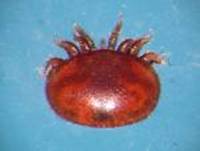
Within the United States, Varroa Mites have the most pronounced impact when compared to other pests within the beekeeping industry. The Varroa Mite is also nearly completely responsible for the decimation and loss of feral honeybee colonies. Some beekeepers have resorted to reverting to small cell beekeeping and many hobbyist are moving towards top bar hives in an effort to fight against this aggressive foe. Others are attempting to use mite resistant races of bee with some success.
Origin
The Varroa mite was discovered in Southeast Asia in 1904, but now unfortunately spread mostly worldwide. More recently Varroa was discovered in 1987 within the US and in 2000 in New Zealand.
Anatomy
Varroa is approximately 1.00 to 1.77 mm in length and 1.50 to 1.99 mm. Its body closely resembles that of a tick, it has eight legs and the apparatus to both pierce the epidermal layer of adult and larval bees in order to feed. The mite is red-brown in colour and wide and plainly visible to the naked eye when on brood, and can be more difficulty spotted, on some occasions, on the adult bee.
Life Cycle
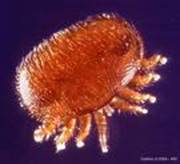
Symptoms & Detection
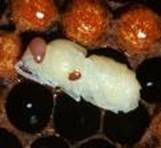
* Mites obvious on brood, emerging bees, or foragers
* Deformed bees
* Discarded larva
* Spotty brood pattern
* Apparently sudden death of colony
* Dead mites found near the entrance of the hive
If Varroa infestation is suspected, there is often nothing major lost by examining. However, a colony may be doomed if left unchecked. Checking for Varroa should be part of a beekeepers regular regiment. The following methods are some common ways to detect a possible mite infestation.
Ether Roll
The ether roll test is the grandfather of the sugar roll test, though effective it is not always the best method, as tested bees will die as a result.
1. Using a wide mouthed jar, such as a mason or pickle jar, collect a sample of bees (not the queen) and fill the jar about 1/3 full.
2. Using ether, such as that from a can of carburetor starter fluid, apply a small amount to the bees (approximately a tablespoon worth). The inside of jar should be slightly moist with all bees at the bottom.
3. Place the lid on the jar and roll bees for about 20-30 seconds.
4. If done quickly, the jar may be opened and some of the bees may escape alive, though this is doubtful and the ones that do survive will be ready to sting.
5. Examine the sides and bottom of the ether filled jar. If you count one or more mites, it is advised that you begin some sort of treatment. If you count around a dozen mites, it means you have a significant infestation, and should immediately begin treatment. If you find more mites than you can easily count, your hive is in serious trouble
6. Dump remaining dead bees and clean the jar before next use.
1. If you can do the either roll, there is little reason not to do the sugar roll instead, as it is not lethal to the bees and is just as time consuming
2. Soapy water or 70 percent isopropyl (rubbing alcohol) can be used with varying success instead of ether
Drone Culling
Unfortunately, the drone culling method kills drones to determine if there is a mite infestation. Despite this fact, culling drones is a quick and reliable method to check levels.
1. Select a frame (or comb) with a large patch of capped drone brood. Gently remove adult bees from the frame and locate it to an easy to work area.
2. Using a capping scratcher to remove the cappings from the selected brood cells. The drone brood within unfortunately must be impaled during this step.
3. Mites will be plainly visible on the pupae as they are removed from their cells. Two to three mites on single pupae indicate a serious problem. Two to three mites per 50 pupae indicate a low to moderate infestation.
4. Remove the culled brood, especially if heavily infected, or allow the bees to clean up after returning the frame to its original hive.
* Caped drone brood can be differentiate from capped worker brood as it has larger cells with slightly domed shaped capping.
* When returning the frame be sure to return it to its original hive, unless you are absolutely sure it does not carry any disease or mites.
* The sugar roll method for detection is a little more time consuming, but no bees must die for it to succeed.
Sugar Roll
The sugar roll method, also called the sugar shake method, is a technique that can be used to fairly reliable determine if bees have an infestation. Unlike the ether roll or drone culling however, when done properly there is no bee mortality.
1. Using a wide mouthed jar, such as a mason or pickle jar, cut a large hole in the lid and affix a rigid mesh in which bees can’t escape, size 8 hardware cloth serves this purpose well.
2. With the jar open add 2 to 3 tablespoons (approximately) of confectioner’s sugar to the bottom of the jar.
3. Scoop the jar about 1/3 of the way full with bees (or 100 to 200 bees), being sure that you have not captured the queen quickly seal the jar with the lid you made.
4. Covering the lid, so as not to lose the sugar, vigorously gives the jar a several shakes. The more the better, to a point, this will surely aggravate the bees but should not cause them any serious harm.
5. Shake the sugar (and mites) out of the jar on to a piece of what paper or something with a similar white background. Set the jar of bees aside in the shade.
6. If you count one or more mites, it is advised that you begin some sort of treatment. If you count around a dozen mites, it means you have a significant infestation, and should immediately begin treatment. If you find more mites than you can easily count, your hive is in serious trouble.
7. Allow your recently jarred and jarred bees then to fifteen minutes rest before returning them to the hive. This is mainly for the sake of the beekeeper, as the bees for obvious reasons may be ready to sting. Although, some of your bees are now covered in sugar and appear to be little ghosts, don’t worry, their sisters are more than up to enjoying the task of cleaning the sugar off of them.
Notes
* Some keepers choose to use a modified sugar roll technique on entire packages of bees, but be sure not to do so to the queen. This technique is only useful when there is no brood, so it may similarly be stretched to include recently captured swarms.
* Although it is not often recommended to use powdered sugar in conjunction with bees, due to anti caking agents that may be present, it should not be a problem with this technique to the little exposure actually obtained.
Screened Bottom Board
Simply installing a screened bottom board allows you to keep mite levels in check without having to actively monitor.
* It is advisable to apply a sticky board, adhesive glue, or a thin layer of Vaseline to the catch tray of the bottom board so that live mites cannot return to the hive.
* As with any passive technique, results are not instantaneous and thereby may not be dependable or arrive at too late of a time
Observation of Bees
If you are easily able to observe mites on foraging bees, the colony is in trouble. Begin to remedy the situation as soon as possible.
Methods of Control
There exist many methods of controlling levels of Varroa mites, each with varying success. Unfortunately most methods are for control only, there may always bee a level of mites in a once a colony has been infected only extremely drastic measure, such as culling the hive, can assure a zero mite population.
Any controls using any sort of chemical device should not be used for up to 30 days prior to a honey flow that will be used for collection of honey for human consumption, unless otherwise noted.
Chemotherapy
Apistain
Apistain is a readily available plastic strip that is treated with a form of miticide. Users should follow the instructions present on the packaging.
Notes
* Understand the instructions fully before applying
* Do not apply when honey supers on the hive
* Most commonly, 1 strip per 5 frames should be used, do not over medicate
* Do not use strips for longer than the time stated on the packaging, this will and has caused mite resistance to the poison.
* Wear protective gloves when applying and removing strips
* Once used, do not reuse strips
* Treatment timing is extremely important for success, do not use more than once in the fall and once in the spring.
* Do not use in conjunction with CheckMite+
CheckMite+
CheckMite+ is similar to the product Apistain in the fact that it is miticide on a plastic strip. CheckMite+ however uses a different miticide that that which is present on Apistain strips. CheckMite+ should only be used if you Varroa mite infestation has proven to be resistant to Apistain. Users should follow the instructions present on the packaging.
* Understand the instructions fully before applying
* CheckMite+ should only be used if you Varroa mite infestation has proven to be resistant to Apistain
* Do not apply when honey supers on the hive
* Most commonly, 1 strip per 5 frames should be used, do not over medicate
* Do not use strips for longer than the time stated on the packaging, this will and has caused mite resistance to the poison.
* Wear protective gloves when applying and removing strips
* Once used, do not reuse strips
* Treatment timing is extremely important for success, do not use more than once in the fall and once in the spring.
* Do not use in conjunction with Apistain
Dusting
A dusting of powdered sugar or wheat flower in conjunction with a screened bottom board or a sticky board can cause mites to fall and be captured. Though this method can be used during honey collection, it should only be used as a last ditch effort. This must be repeated once a week for two to three weeks to make any kind of lasting effect.
Notes
* Only dust the adult bees, as open brood may perish due to dusting. However it may be said that Dr Fakhimzadeh of Helsinki University has suggested that sugar DOES NOT have a negative effect on open brood and eggs damage only seems to occur when dusting with sugar and Oxy-Tertra-Cycline (OTC) indicating that it is the OTC that is doing the damage. Nevertheless Jim Fischer of WSBA points out that we should avoid open cells ready for laying as the queen will only lay in clean cells
* This process must be repeated as it will not affect mites that are sealed in cells with brood or affect mites that are piggybacking on absent foragers
Drone Culling
Similar to the method of detection of the same name, drone culling can be used to reduce the number of mites infesting a hive. This process can be done as hone supers are on the hive.
1. When starting a colony, use a sheet of drone brood foundation, per hive body.
2. Occasionally when the brood comb is full simply cull the drones by placing the entire frame in the freezer.
3. Once frozen comb has defrosted replace it in the hive to allow the bees to clean it and refill the comb.
4. Repeat as necessary.
* If drone foundation is not available, take about an inch tall piece of normal foundation and simply used this as a starter strip by installing it on the top of a frame. This method allows the bees to create their own comb, though it may not always be successful in creating drone comb.
* Instead of freezing, uncapped drone brood can be hung in order to feed local birds, but do not replace the frame in this instance as it will be more than likely destroyed by the appreciative birds.
* Instead of freezing drone can be culled by heating, though this often readily becomes a waxy mess is not kept under control.
Breaking Brood Cycle
The act of breaking the brood cycle, by culling the queen, and allowing the bees to raise their own queen will prevent Varroa mites from laying eggs and thereby end their life cycle.
* Instead of culling a healthy and productive queen, she can be used to requeen a separate hive or begin a Nuc.
* Instead of using a self produced queen, you can replace with a store bought queen, but you must allow for a natural broodless cycle
* This method could be used during a honey flow, but a lack of new workers will cause it to be poor honey season.
Natural Methods
Grease Patties
Using grease patties with or without essential oil will cause a decrease in tracheal mites. They are sometimes used as a varroa mite control method. Though it is preferred to use patties with essential oils, it should not be done during a honey flow. To be effective, grease patties must remain on the hive year round.
Essential Oil Treatment
Using essential oil in a sugar syrup feed as been shown to reduce mite levels. Syrup feed should not be supplied when honey suppers are on the hive.
Tobacco Smoke
A heavy tobacco smoking in conjunction with a screened bottom board or a sticky board can cause mites to fall and be captured. Though this method can be used during honey collection, it should only be used as a last ditch effort. This must be repeated once a week for two to three weeks to make any kind of lasting effect.
* When smoking, be sure that the smoke is not too hot, use cool smoke only
* This process must be repeated, as it will not affect mites that are sealed in cells with brood or affect mites that are piggybacking on absent foragers
Formic Acid
Formic acid is very caustic, and toxic to both bees and humans if not used properly. The liquid form of formic acid is too dangerous to use, and should be avoided all together. Beekeeper supply houses may sell a time-release gel form that is easier to use and less toxic.
The homoeopathic potency is even less toxic than that and can be used safely for bees, while still getting rid of the varroa mite.
* Follow directions before using
* Take caution in use as it is toxic to bees and beekeeper alike
* When used, formic acid will also treat tracheal mites
Food Grade Mineral Oil
Some beekeepers use an electric or propane insect fogger to apply a mist of food grade mineral oil to their bees. This has been shown to induce a grooming behaviour in the bees which can reduce mite levels when combined with a screened bottom board.
Wax Moth
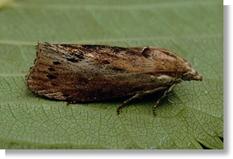
It is emphasized that the wax moth is generally not responsible for the death of a colony. Rather this insect is a “garbage man” of sorts; moves into areas unprotected by worker bees, and can be an early warning signal that everything is not well with a colony. Strongly populated honeybee colonies always have wax moths, but are unaffected because the moth larvae are being continually sought out and then cast out of the hive. Only when a colony becomes weak in numbers because of disease, starvation or some other occurrence, does the wax moth move in to “clean up” the colony by consuming the comb.
Wax moth is a consistent and vexing problem in stored comb; the rate of moth development in a stack of stored supers rivals the imagination! Traditionally, stored comb has either been heated, cooled, or fumigated with chemicals to deter wax moth infestation.
A bacterial disease spore, which attacks only wax moth larvae, is now marketed under the name Certan for control. This material represents a breakthrough because the disease is so specific it cannot harm either bees or people and can be used with little concern around bees or equipment. However, its application is labour intensive and not favoured by large-scale operators. Several chemical fumigants that have been used in the past were methyl bromide, aluminum phosphide, ethylene dibromide (EDB) and paradichlorobenzene (PDB). At present, only aluminum phosphide and PDB are approved in Florida.
Of these, paradichlorobenzene is less dangerous to the applicator and easier to apply. Unfortunately, it does not kill all stages of wax moth and so remains more of a preventative; it will not clean up a severe case.
Again, it is advisable to buy any chemicals for beekeeping use from bee supply houses; this way full information on use of the substance in beekeeping is available. All pesticides must be labeled for use on stored comb; the label is the law, under no circumstances should a pesticide be used, if that use is not specified on the label. Beeswax is similar in structure to many insecticides and often has an affinity for these substances. As a consequence extreme caution should be excercised when using pesticides anywhere near a beekeeping operation.
For further information on toxicity of pesticides, see Florida Cooperative Extension Circular 534, Protecting Honeybees From Pesticides.
There is a range of temperatures required to kill all stages of wax moth using cold or heat treatment as published in Farmers’ Bulletin Number 2217 “Controlling the Greater Wax Moth. A Pest of Honeycombs,” USDA Science and Education Administration, 1981.
Care should be taken when treating with cold because beeswax becomes brittle and breaks easily. Even more caution, however, is advised when heat-treating combs. They should only have very little honey to avoid distorting the wax comb, must be placed vertically in supers and the heat must be circulated to avoid creating hot spots which could melt the comb. Consult referenced works for more information on wax moth control.
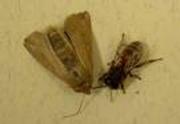
The beekeeper is more likely to see the adult moth but it is the larval or caterpillar (worm) stage that causes damage to wax comb. The larva is most destructive to beeswax combs in storage, especially in areas that are dark, warm and poorly ventilated. Annually it is estimated that the wax moth causes more than 5 million dollars in losses to beekeepers in the U.S.
The wax moth is regionally called the bee moth, the wax (or bee) miller or a webworm. There are both a greater wax moth, the most destructive comb pest, and a lesser wax moth, which, due to its smaller size, is less serious. There are three related moth pests of stored products that may also be found on combs or in bee hives. These are the Mediterranean flour moth, the Indian meal moth and the dried fruit moth. These last 3 feed mainly on pollen and are less destructive as they do not make extensive webs in the wax combs.
Most beekeepers know the damage wax moths cause. The moth life cycle consists of 4 stages. The first life stage, the egg, is tiny. Eggs are not noticeable unless we specifically look for them. Usually the female adult lays her eggs in batches. The eggs are laid in cracks between hive parts in dark out of the way places. Females produce up to 300 eggs each.
Wax moth eggs hatch to the larval stage in 5 to 8 days. New larvae burrow into beeswax comb attempting to reach the comb midrib. They are specialists to eat and grow and feed for 1 to 5 months, depending on the temperature. When fully grown, they are 3/4ths of an inch long and look like your typical caterpillar. They have a dark, hard head capsule, 3 pairs of small, segmented legs and several body segments, some of which have caterpillar prolegs. They are white initially, turning dark grey as they age.
In contrast to its name, the wax moth does not digest beeswax. It lives on impurities in comb and for this reason prefers to infest beeswax comb that has been used for brood rearing. Foundation is seldom bothered and only by small larvae that often die before reaching the adult stage. In capped honey, young larvae tunnel just below the cappings. This causes harvested honey to leak from packages and makes comb honey less attractive and saleable.
The third life stage, or cocoon, is a transformation life stage from caterpillar to adult. Fully-grown larvae spin a silk cocoon that is dense and tough. It does this in comb or in debris at the bottom of the hive but more frequently it is firmly attached to the frame or hive body. The cocoon is cemented into a boat-shaped cavity the larvae chew in the wood. This damage persists in equipment long after the wax moth emerges. Once the cocoon is spun, larvae change to the pupal stage.
Wax moth pupae may hatch rapidly or take 2 months to change to the adult stage depending upon temperature. Adults are 3/4ths of an inch with longer wing span (1 1/4 to 1 ½ inches). Males are slightly smaller and can be distinguished by a scalloped front wing margin compared to a smooth one in females. The wings fold roof-like over the body; wing scales and body are a non-descript grayish-brown. Adults often run before they take flight when disturbed.
Wax moths fly mainly at night. During daylight they rest in dark spaces. They have acute sensory capability to find and exploit beeswax. They readily enter bee hives to lay eggs but the bees keep their numbers under control. It is in stored equipment or in weakened or die out colonies that their numbers explode. We then find all 4 life stages, tunnels of silk throughout the combs, especially near midribs, deposits of dark fecal matter, cocoons stuck to frames everywhere and a disintegrating comb structure. If left to continue or not quickly detected all the beekeeper is likely to see is the gritty debris of comb remains on the bottom board and boat-shaped cocoon attachments with no or little comb left intact.
CONTROL OF WAX MOTH IN COLONIES
The bees themselves are the best control of wax moth in active bee colonies. It is not unusual to find an occasional wax moth adult or larva in a colony. They will be in out-of-the way places and in areas bees can’t get to, such as areas between top bars and inner covers. The bees may even have sealed the caterpillar off with a propolis fence. If you have many combs, especially darker combs that have had brood in them, or a weak colony, more wax moths and their damage may be evident. Beekeepers frequently state that wax moths are responsible for killing their colony. They are not capable of doing this.
What has happened is that the colony became weak, or more likely lost its queen, and the population dwindled to where there were too few adults to protect the combs. The adult female lays her eggs and the caterpillars hatch and grow. The caterpillar protected in its silken tunnel is hard for the bees to remove. Before the beekeeper discovers the weakened or queenless colony, the damage can accelerate. Under favorable conditions in the southern U.S. or tropical climates, wax moths can completely destroy brood combs in a month.
In addition to insuring active, populous colonies, keeping the hive clean and free of debris can help reduce wax moth damage. The bees need access to all parts of the hive. Don’t neglect to remove the debris that accumulates on the bottom board or in cracks and crevices. Reasonable removal of burr comb and propolis will also help remove places where wax moths can become established.
CONTROL IN STORED COMBS
When we remove and store drawn comb, we increase the opportunity for a wax moth infestation. The warmer the temperatures, the more vigilant we must be. Simply trying to put frames in plastic bags won’t be enough because eggs could already be present. Storing drawn comb outside in the open air won’t suffice either unless you are in an area of freezing winter temperatures of the northern states. If you store comb, plan to protect it from wax moth.
Several materials have been used to fumigate beeswax combs before placement in storage. For beekeepers in more northerly states, one fumigation may suffice as normal winter temperatures will keep wax moths under check over winter.
Currently paradichlorobenzene (PDB) is the fumigant of choice. It can be purchased from bee supply dealers or at hardware and drug stores everywhere. Be sure you purchase 100% PDB and not the other common moth fumigant naphathlene.
PDB is heavier than air so you don’t need to put it at the bottom of a stack of supers/hive bodies. Since it does not kill the egg stage, you need to be sure you have a continuous fumigation in areas of high temperatures. PDB cannot be used to fumigate honey filled combs.
Beekeepers build or purchase various types of structures to store drawn comb when not in use on colonies. Some beekeepers fumigate and then store combs in more wax moth proof enclosures. You can also store combs outside, stacked so you can fumigate as well as keep rodents and weather damage to a minimum. The queen excluder is helpful to keep stacked equipment rodent proof.
PDB works best above 70oF as it volatilizes to the gas state. It is non-explosive and non-flammable. Since beeswax comb can absorb the gas odor, you should air combs that you remove from storage before using them on bee colonies. To get the best fumigation, stack your hive bodies as tightly as possible, even taping cracks and broken covers. Use 3 ounces of crystals for each stack of 5 full depth boxes or 8 half depths.
Placing the crystals on a piece of cardboard or newspaper is preferred over putting the crystals directly on the top bars. Remember the gas is heavier than air so you should put the crystals at the top of the stack. Keep the bottom closed to help retain the fumigant in your equipment stack. If the ambient temperature remains high, check the crystals every month or so and replenish as necessary.
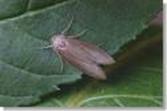
You can use carbon dioxide to fumigate honey for sale as well as to fumigate drawn comb you will store in moth proof enclosures. Some fruit and vegetables are treated with carbon dioxide so you might be able to use the existing facility of a farmer in your area rather than build a unit of your own. You need a 98% CO2 concentration for 4 hours under slight heat (100oF) and moderate (50%) humidity to adequately protect against wax moth. Longer fumigation under less ideal conditions may not necessarily suffice.
Of course if you can find the homoeopathic potency of CO2, the drawbacks of other methods are immediately overcome, because it does not have them. Some counties produce this as a remedy, others do not. A good place to order is from Similia in New Zealand
Alternatives are to use heat or freezing temperatures to protect honey in the comb. Both methods are temperature and time dependent. The colder or hotter the temperature the less time required. For example at 20oF you should leave comb honey in for 4 1/2 hours but at 5oF you need keep it only 2 hours. If you use heat you need at least 115oF for 80 minutes of exposure or 40 minutes at 120oF. Above 120oF you may melt wax. Be sure you get even distribution to avoid hot pockets. Cold is generally easier and safer to use than heat, since a freezer works quite well.
Heat or cold treatment is preferred over PDB fumigation by queen and package bee producers. There is no odor or chemical residue that may interfere with queen rearing.
You can also buy a small quantity of PDB and try to potentise it yourself. Take a tea-spoonful of the substance and grind it to the finest powder in a mortar, accompanied by lactose or sugar. Once ground down for about 3 hours, dissolve the sugar in water and add some alcohol for preservation. This is your tincture.
Next you take a teaspoonful of that and mix this with 100ml of water, by banging the bottle bottom on a book ten times. From this mixture, take 1 teaspoonful and mix with 100ml of water, again repeating the shaking of the bottle ten times. From this again 1 teaspoonful is taken and the process is repeated again. By the time you arrive at the sixth bottle, you empty this in your spray tank and fill with water, stir for ten minutes and apply. No poisonous residues will remain and it is safer for the bees.
NATURAL CONTROL
A natural microbial bacteria Bacillus thuringenisis (Certan®) has been discovered that is specific for wax moth. It was once available for sale by bee supply companies but is no longer manufactured. Other Bt’s (Dipel, Thuricide) widely used to control caterpillars are not fully effective against wax moth. A virus also kills wax moth under natural conditions but no commercial preparation is available. Using the sterile male release technique has been shown to be a possible control strategy under test conditions but no program currently uses this methodology.
There are traps available for stored product pests such as Indian meal and Mediterranean flour moths. They use synthetic sex attractants and live captured females to trap and eliminate the males. So far a trap effective against the wax moth has not been developed as males apparently do not rely solely on chemical pheromones to find females; they also use ultrasound. A component of the female sex pheromone Nonanal is also found in beeswax and may help explain how wax moths find beeswax for oviposition.
Wherever wax moths exist we also find a wasp predator – a braconid wasp. It helps keep numbers down in an outbreak situation but is not effective enough for beekeepers to use in on-going moth control. This wasp is available commercially and can be potentised and made into a remedy.
Beekeepers will never completely win the battle against wax moth. It is an insect well adapted for surviving around bee colonies. We need to be vigilant to not allow wax moth to take more than their share of drawn comb that the bees work so hard to produce.
Essential oils are strongly scented oils that are created through the distillation of plant materials. Most commonly derived from the flowers, leaves or stems of a plant, they may also be derived from fruit or the skin of a fruit. Many of these oils have common uses in aroma therapy and alternative medicine. Beekeepers however, also may have a used for a select few of these common oils
Essential oils can often be found in health food stores or aromatherapy shops, the price may be high, but keep in mind that a little oil will go a long way.
Commonly Used Oils
There exist a wider variety of essential oils. In general, beekeepers are only interested in a few of them. The following is a list of some of the more common oils that may concern a beekeeper.
Banana
Though it has been unconfirmed, reports state that banana oil seems to closely mimic the alarm pheromone of honeybees. Because of this it is advised against using banana oil, or other strong banana scented products near or around hives. It is unclear whether bananas can be safely eaten near honeybees, but it is likely that no adverse result would be seen.
Lemon Grass
Lemongrass works conveniently as well as the pheromone created by the honeybee’s nasonov gland, also known as attractant pheromone. Because of this lemon grass oil can be used as a lure when trapping swarms or attempting to draw the attention of hived bees. Be warned however that lemon grass oil can cause a robbing behaviour if it is used within or on a weak hive.
The homoeopathic tincture may here be even more effective, as it is both a pheromonal repellent and an active remedy against the wax moth.
Peppermint
Peppermint oil is used as a general-purpose pheromone masking scent. It does not apparently mimic any known bee pheromones and is simply used to mask others. In theory any other strong scented essential oil would work the same.
Also here the homoeopathic tincture is preferable above the pure oil, since the strength of the smell is not so overpowering and because it is taken up by the pest.
Spearmint
Spearmint oil is often used in conjunction with lemon grass oil during feeding to improve hive health and work as a recruiting scent.
Also here the homoeopathic tincture is preferable above the pure oil, since the strength of the smell is not so overpowering and because it is taken up by the pest
Spearmint and Lemon Grass
Spearmint oil and lemon grass oil are two essential oils that are commonly used in conjunction to complete many tasks with bees. A simple general-purpose essential oil mixture can be used for many things, including avoiding the reliance of smoke when opening hives.
In homoeopathy mixtures are not used, except by those not sufficiently schooled in the subject. Hence we refer back to the above headings for truly effective treatment.
Tea Tree
Tea Tree oil is often used in grease patties for control of mites. It seems as if Tea Tree oil can be interchanged with wintergreen oil with no loss of effectiveness. The homoeopathic tincture will produce even better results.
Wintergreen
Wintergreen oil is often used in grease patties for control of mites. It seems as if Tea Tree oil can be interchanged with wintergreen oil with no loss of effectiveness.
The homoeopathic tincture will produce even better results.
Essential Oil Therapy Versus Mites
Varroa Mites
Essential oils, in regards to mite control, have two apparent modes of operation. Primarily, direct toxicity. In the case of varroa mites, once a mite comes in to direct contact with an essential oils such as wintergreen or tea tree oil mixed into a grease patty they are usually killed within a few minutes. This however, requires that the infected bee actually contacts the grease patty. Due to this direct contact requirement, direct toxicity cannot eliminate mites, only aid in the control of mite levels. Secondly it appears that mite reproduction can be impaired when bees are fed a syrup containing essential oils. Essential oils are passed from feeding bees to other bees and larva through trophalaxis. Essential oils thereby pass to the brood that ingest the oils and poison any female Varroa that attempt to parasitically feed on the larva.
Tracheal Mites
Similarly essential oils appear to have an impact on the breeding and control of tracheal mites, however the effects of tracheal mites are difficult to observe and the mechanism that causes the control is in debate. It appears that the best therapy, in regards to tracheal mites and essential oils, is the usage of grease patties.
Better still are homoeopathic tinctures, since they also render the pest unconscious, due to their alcohol content.
Treatment
It is recommended that that grease patties containing essential oils, and other medicaments as desired, are kept on the hives throughout the winter and any season when honey collection for human consumption is not taking place. Grease patties not containing and essential oils or medication should be kept on hives throughout the rest of the year. During times of the year that temperatures allow for flight, and honey is not to being collected for human consumption, colonies should be treated with syrup containing essential oils.
———————————————————-
V.D. Kaviraj is a Dutch homeopath, author, researcher and pioneer in Agrohomeopathy. He has written textbooks on various aspects of homeopathy including “Homeopathy for Farm and Garden”.


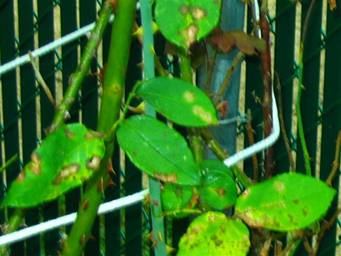
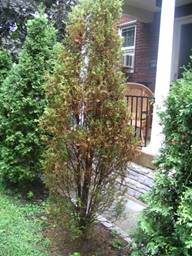

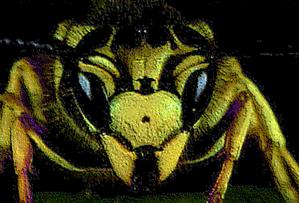

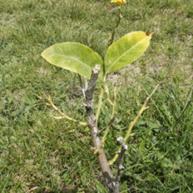


I have a ponytail palm that has white spots on the leaves I would like to find out if it will harm my palm and what to do to get rid of it. Thanks Bev.
I have a large beauganvillea that I would like to remove. I’ve cut it to a foot and the roots grow under the house. Any thoughts? Thank you